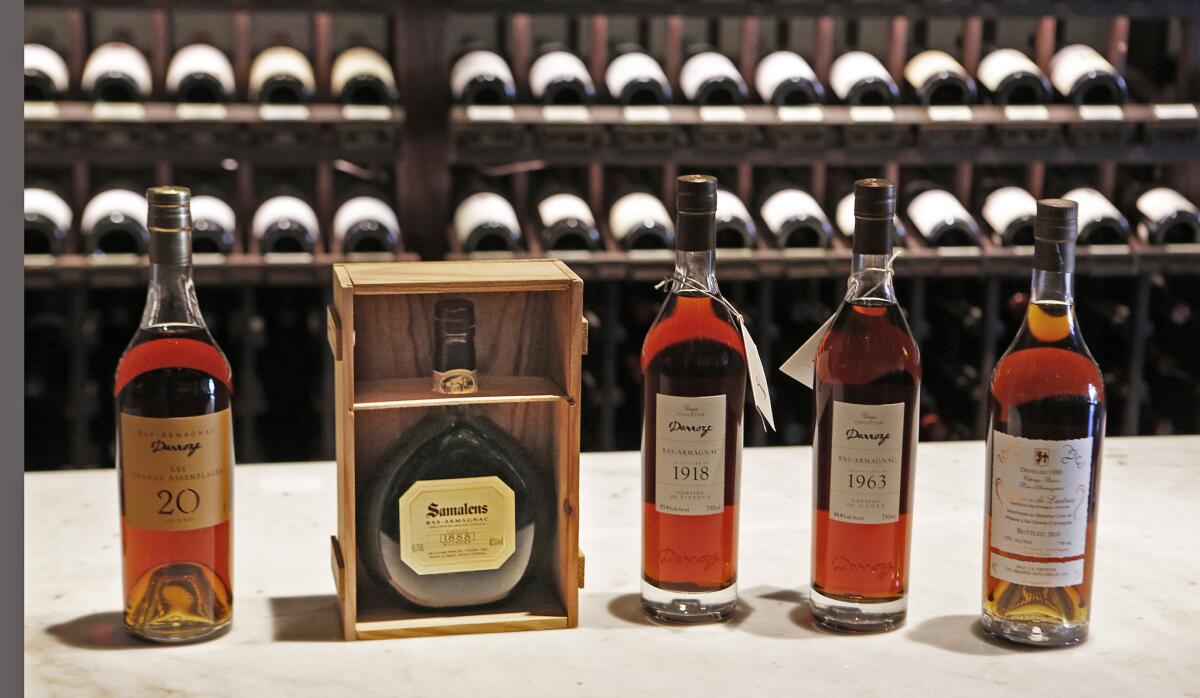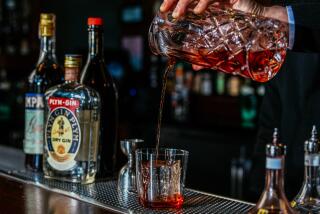Everything you need to know about Armagnac, the small-batch brandy

An assortment of Armagnacs. These happen to be at Wally’s in Beverly Hills at prices from $150 to $4,500.
- Share via
In Georges Simenon’s iconic series of French detective novels from the ‘30s, after a particularly harrowing case, Inspector Maigret often nips into a bar to smoke his beloved pipe with a glass of brandy. And for the intrepid Paris inspector, that inevitably means an Armagnac.
It is the oldest of France’s brandies with roots back to the 10th century. Like Cognac, Armagnac is distilled from wine. But the relationship between the two brandies is a little like mezcal’s to tequila. Armagnac is the little guy, produced on small farms in Gascony, the heart of southwest France. Cognac, produced 150 miles to the north, with different grapes, on different terroir, has 10 times the production.
In Paula Wolfert’s “The Cooking of Southwest France,” two-star chef Alain Dutournier of Carré des Feuillants, who grew up in the region, characterizes the differences between the two spirits this way: “Cognac is dependable, but Armagnac, like the Gascons who make it, is more forceful, more complicated — even excessive at times — and more exciting.”
To importer Charles Neal, the artisanal spirit appeals to the same people who might be interested in European film directors or independent music. “It takes a little bit more effort to get into and the rewards once you do so are greater as well.”
Armagnac is also distinctive because of the way it is distilled. Cognac producers use pot stills and distill twice, whereas Armagnac is distilled just once in a continuous still known as an alembic armagnaçaise. One of its virtues is that it is portable, so it can travel around to small properties. The spirit that emerges retains more character. Rougher at first, a young Armagnac tastes of fire and earth. But after aging in white oak barrels for decades, the spirit is tamed and softened and becomes marvelously nuanced.
Armagnac’s quality depends on the grapes and their terroir, how carefully the wine is distilled, how long the spirit is aged in oak casks — and what kind of casks — and, obviously, the skill of the cellar master in making a blend. Not all Armagnac is blended, though. Some of the most prized are vintage-dated and come from a single property.
The older the Armagnac, the more spirit has evaporated over the years, giving up what’s called the “angels’ share.” An Armagnac can be too old and taste dried out, cautions Neal, who has written a book on the subject. In his view, Armagnac peaks between 18 and 30 years of age. Once the spirit is bottled, it stops evolving. So a 1993 Armagnac bottled in 2010 is actually only 17 years old, not 22.
Younger Armagnac is paler in color, since it has spent less time in oak. Fruit flavors such as prunes, quince and apricot come forward. Give the brandy some years more and the color darkens, tannins soften and it begins to taste of toffee, chocolate and caramel. As the spirit ages longer, you’ll find sweet spices such as cinnamon along with candied fruits and black pepper.
Much of Armagnac is made in such minute quantities that it’s never exported — one reason to visit the region. Some estates might, for example, might make just 250 or 500 cases a year. Some brandies are aged and bottled by negociants. One of the best houses is Darroze, which began when local restaurateur Francis Darroze began scouring the countryside for Armagnacs tucked away on small farms and estates.

The label on the back states the Unique Collection Darroze, Bas-Armagnac 1918 Domaine De Picpout has been matured for 61 years in an oak barrel.
The company is now run by his son Marc, who has continued the practice of buying from small producers and aging the Armagnac in the firm’s own chais (aboveground cellars), often for decades. Vintage Armagnacs are bottled with the individual estate’s name on the label. Darroze has also developed a brilliant line called Les Grands Assemblage, which blends Armagnacs of different ages and provenance.
In Gascony, one of France’s greatest gastronomic regions, Armagnac is everywhere. It’s used in cooking too, for macerating velvety prunes, which are sometimes then used to make ice cream. But it’s also a fine addition to daubes, poultry dishes and desserts. The most famous in the region is tourtière, a tart of fragile handmade pastry leaves filled with prunes and sprinkled with — what else but Armagnac.
::
The best way to taste Armagnac: Where does my nose go?
The best way to enjoy Armagnac is by sipping it out of a brandy snifter. That’s a stemmed glass with a wide, round bowl, the idea being that you warm the spirit by holding the bowl with your hands. Some aficionados, though, favor a narrow stemmed glass something like a sherry copita that focuses the brandy’s aromas and flavors.
Charles Neal, an importer and author of “Armagnac,” has gone back to the brandy snifter for a number of reasons. “Because we’re so used to drinking wine, people tend to stick their nose right in and get a big hit of alcohol,” he explains. That’s not the way to do it. “But if you take that glass and turn it at an angle, you can find the sweet spot where the fruit and oak aromas are emerging from the glass and not only the alcohol.” Holding the bowl of the snifter in your hands warms the spirit and releases the aromas even more.
To taste Armagnac, first, observe the color. Then bring your nose close to the glass — without swirling — to take in the aromas. Next, take a small sip. No gulps. A few drops, really, are all you need to experience the brandy’s nuances. Notice the layers of flavors and the finish. How long it persists is a good indication of the Armagnac’s quality.
::
A dream list of Armagnacs
Imagine you’re having dinner at a restaurant in southwest France. You’ve had your foie. You’ve had your duck. And quite possibly you’ve had your black truffles. Now the waiter rolls a cart laden with bottles of Armagnac toward your table, some with handwritten labels or the image of a château. If you see a Laberdolive among them, pick that, the ne plus ultra of Armagnacs — expect to spend a bundle on a single glass and it’s completely worth it. Sometimes you have to pay for greatness. Fortunately, there are fascinating Armagnacs at many price levels. But be aware that although Armagnac can be considered a bargain compared to other spirits for its quality, it is not inexpensive.
Here are some others to pluck off that imaginary cart of spirits:
Domaine Boingnères Bas-Armagnac “Réserve Spécial”
This Armagnac comes from one of the region’s best estates, which goes back as far as 1807. Distilled from a blend of Uni Blanc and Colombard, it is fire and earth, with notes of forest, caramel, plums and vanilla. From $105 to $130.
Château de Briat Baron de Pichon-Longueville Bas-Armagnac “Hors d’Age”
Deep in tone, tasting of dark caramel, chocolate and burnt orange, this is an Armagnac to linger over. The property was acquired by the Baron de Pichon-Longueville in the 19th century and still belongs to the family that once owned the famed Bordeaux estate of the same name. From $70 to $90.
1999 Darroze Domaine de Rieston Bas-Armagnac
Distilled from100% Folle Blanche, this is a vintage Armagnac with lovely notes of pear and quince and an appealing rustic singularity. Bottled only when Darroze gets an order, this is one to savor. From $115 to $130.
1974 Darroze Domaine de Sartoulat Bas-Armagnac
Deep amber, this vintage Armagnac made from 100% Baco grape is a little rough and sexy, truly something to contemplate. A mere drop floods the palate with flavors of dried fruit, honey and something woodsy. The finish is long. About $210.
Darroze Grand Assemblage 40 year Armagnac
This beautiful blend of older Armagnac is warm in tone, voluptuous, with gentle aromas of caramel and forest. This is a bottle to covet. The $250 price too steep? Try the 20 year at $140.
Château de Tariquet Bas-Armagnac XO .
Pleasant entry-level bottle from a reputable chateau. The youngest of the brandies in this blend has been aged at least 15 years. You get fresh fruit aromas but also some candied and dried fruit, toast and vanilla. From $73 to $80.
1970 Laberdolive Domaine du Pillon Bas Armagnac
Relatively new to this country, Laberdolive is the gold standard. One sip and this is the one you want but most likely can’t afford. When you do find it in a wine shop, the 1970 is likely over $600. But then again 20/20 Wine Merchants has a bottle of 1911 listed at $4,500. Best scenario: try a glass at a restaurant when preferably a very rich relative is paying. Over $600.
Extensive inventories of Armagnac are available at Hi-Times Wine Cellars in Costa Mesa, K&L Wine Merchants in Hollywood and Wally’s Wines & Spirits in Los Angeles and Beverly Hills. You can also find a good selection at 20/20 Wine Merchants and Wine House in Los Angeles and Woodland Hills Wine Company in Woodland Hills. But every fine wine retailer should have a bottle or two of something interesting.
More to Read
Eat your way across L.A.
Get our weekly Tasting Notes newsletter for reviews, news and more.
You may occasionally receive promotional content from the Los Angeles Times.










